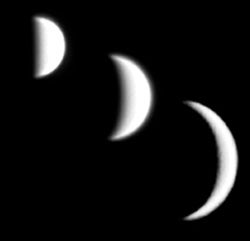Galileo discovered the phases of Venus while studying this planet with the newly invented telescope in the early 1600s. To him, the phases were proof that Venus circles the Sun — instead of Earth, as was the prevalent belief in his time. The first half of 2007 provides an excellent opportunity to repeat Galileo’s historic observations.
As the new year begins, Venus is nowhere to be seen, having reached superior conjunction on the far side of the Sun in late October. “First light” will occur near mid-January, when Venus emerges from the Sun’s glare, making its entrance as a brilliant point of light low in the southwest sky just after sunset. A telescope magnifying just 50x will transform this sparkling gem into a white, featureless, gibbous “Moon.” Higher powers won’t improve the view because of the air turbulence prevalent so close to the horizon. No wonder astronomers prefer to study sky objects overhead!
From January until early June, Venus will climb higher and higher above the western horizon. If you make weekly telescopic observations, you’ll see Venus grow in apparent size but the percentage of its illuminated surface decrease. The latter phase coincides with greatest eastern elongation from the Sun in early June. After that, things rapidly happen, as Venus begins to swing between the Sun and Earth and plummets toward the western horizon. Its disk will continue to grow while its phase diminishes to a thin crescent. Venus will disappear from view in August, with inferior conjunction, when Venus lies between Earth and the Sun, occurring on the 18th.
We can visualize Venus’ changing face, or demonstrate it to others, by moving a ball (Venus) around a lightbulb (the Sun). When the ball is on the far side of the bulb, its illuminated side faces us, and we see the full phase. As the ball moves toward the left side of the bulb (the way Venus orbits the Sun), it appears to grow in size, but shrink in phase, as it takes on a “half-Moon” appearance. Continuing to a position nearly between the bulb and us, the ball becomes a large crescent.
There was a time not so long ago when astronomers envisioned Venus as a planet similar to ours in more than just size. While it’s true Venus orbits the Sun some 25 million miles (40 million kilometers) closer than Earth, it was thought the dense cloud cover, possibly consisting of water vapor, reflected away much of the Sun’s heat and light. Some science-fiction writers portrayed Venus as a warm tropical world teeming with life. Beginning in the 1960s, space probes from the Soviet Union and the United States put that fantasy to rest.
We now know the atmosphere — composed mostly of carbon dioxide — acts as a greenhouse, letting in small quantities of sunlight. The sunlight, when absorbed on the surface and converted to heat, becomes trapped. The surface temperature on Venus is a scorching 850° Fahrenheit (450° Celsius) — even hotter than Mercury’s surface! The air pressure at the surface is more than 90 times what we experience at sea level on Earth. That’s equal to the crushing pressure exerted by the ocean a half-mile down. It gets worse! The clouds, far from being just water vapor, are largely sulfuric-acid droplets. This goddess has a dark side, indeed.
Questions, comments, or suggestions? E-mail me here.
Check out my observing-basics debut on Astronomy‘s podcasts. You can listen to it January 5.











